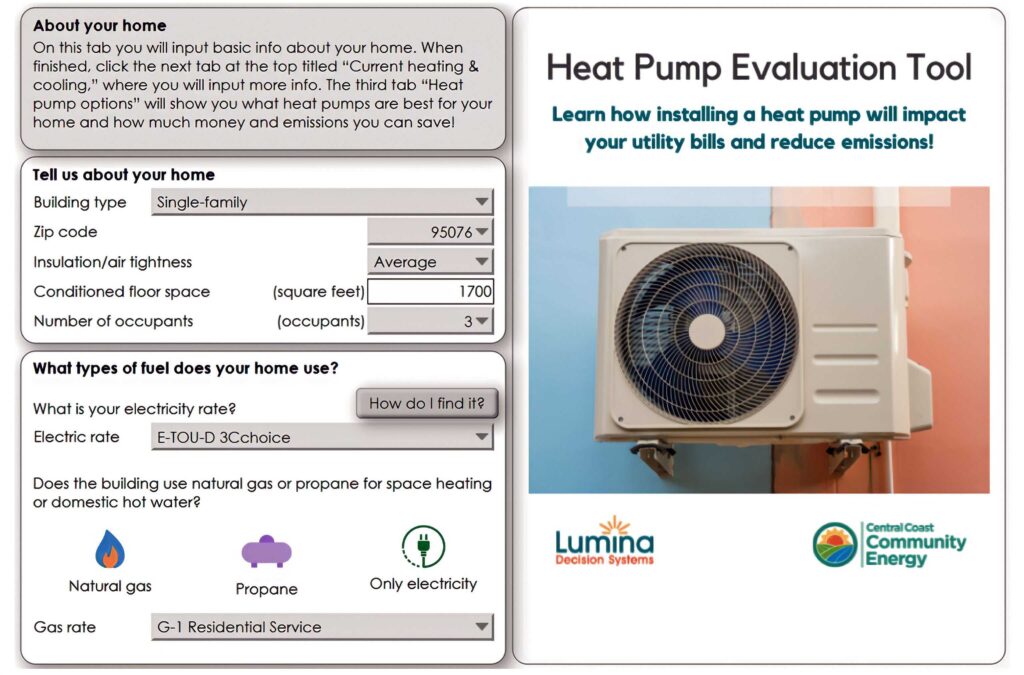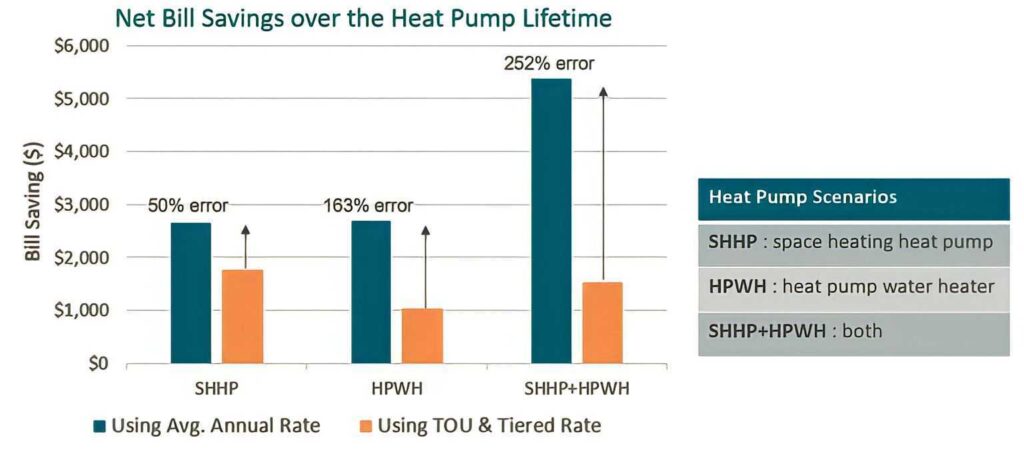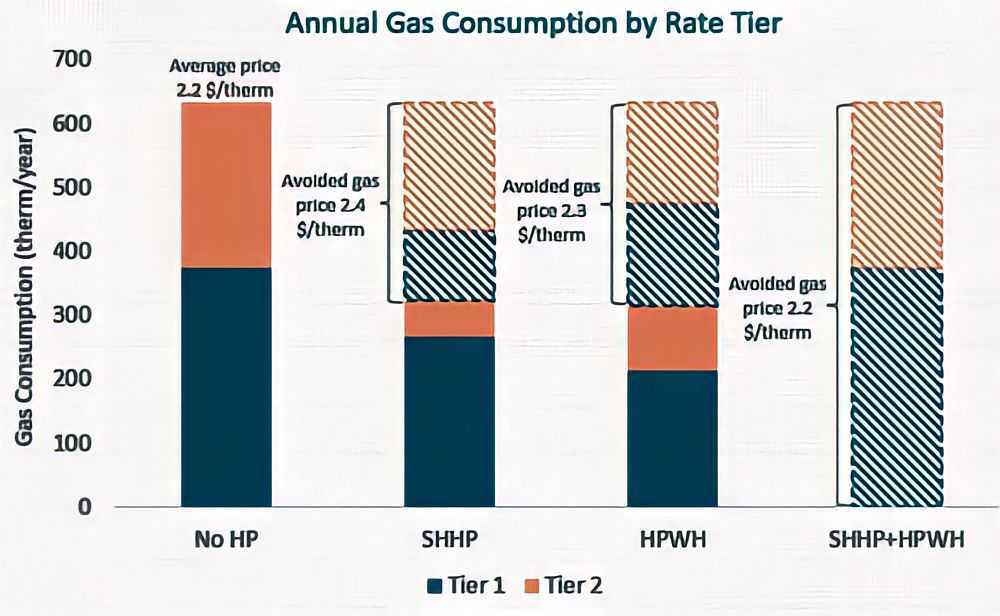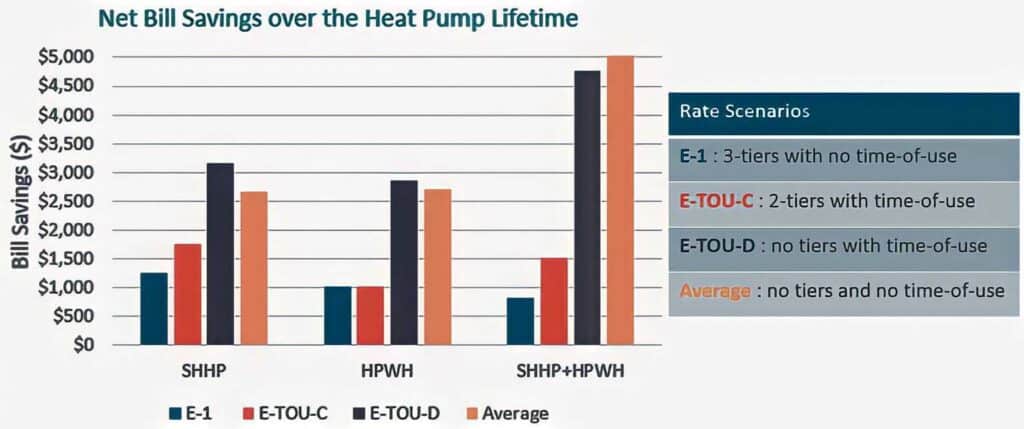Most online calculators that estimate utility bill impacts of heat pumps are highly misleading because they ignore time-of-use and tiered electric and gas rates. Accurate calculations must consider when heat pumps are used, how outdoor temperature affects efficiency, and the complexities of rate structures.
Lumina partnered with Central Coast Community Energy to release a more accurate heat pump bill savings calculator that accounts for these details. We used the tool to show how simplistic calculations that assume annual average electricity and gas rates substantially skew the results. We also show which types of rate are most advantageous to heat pump owners.

The main screen of Lumina’s online Heat Pump Calculator.
Homeowners need accurate information
Many states, cities, and utilities promote beneficial electrification as a way to reduce carbon emissions and other pollutants by shifting from space and water heating from natural gas to high-efficiency electric heat pumps. Since electricity generally costs more than gas for an equivalent amount of energy, it’s difficult for homeowners and contractors to know whether switching to heat pumps will reduce utility bills. It’s made even harder by modern rate structures that price electricity differently by season, time of use (“TOU”), and consumption level (“tiers”).
Why is an accurate analysis so difficult?
There are three key reasons why estimating heat pump bill savings can’t be penciled out on the back of an envelope:
- Energy rate structures are often complex and heavily influence utility bills
- Energy use by appliances varies over time and depends on the weather
- The efficiency of space conditioning heat pumps varies with outdoor temperature
Rate structures
Rate structures are becoming increasingly more complex as utilities try to better align price signals with the cost of delivering energy. Nowadays, prices can vary by season, time of day, consumption level, or some combination of these. Prices can be significantly higher during on-peak hours, and knowing how much energy consumption falls in those high-priced hours is no easy task.
“Tiered” rates that use different prices for thresholds of monthly consumption mean that the bill impacts for each appliance may depend on total usage by other appliances within a home. If increased consumption causes a home to move into a more costly electric tier—and/or a decrease in gas consumption causes a move into a cheaper gas tier—it can appreciably change the heat pump economics.

Tier 2 adds nine cents to the price per kWh when monthly consumption surpasses a threshold (e.g. 300 kWh).
Time- and weather-dependent consumption
With time-of-use rates that vary by hour of day, electricity cost depends on how each appliance varies hourly energy use in response to occupant behavior, outside weather, and indoor temperature settings.

Daily consumption does not scale linearly with indoor setpoint temperature, nor does the amount of consumption falling in high-priced periods.
Heat pump efficiency varies by outdoor temperature
A gas furnace typically has the same efficiency near 80%, irrespective of outside air temperature. But an air-source heat pump efficiency typically decreases with the difference between inside and outside temperatures. So heat pump efficiency is generally lowest when space heating needs are highest, and vice versa.
This nonlinear relationship means that accurate consumption estimates must pair temperature-dependent efficiencies over time with actual heating load, instead of simply dividing average load by average efficiencies.

The coefficient of performance (COP) is the ratio of useful heat output to electricity input. A COP of 3.5 means it operates at 350% efficiency.
How does this impact bill savings estimates?
Let’s consider an archetypical home with gas and electricity supplied by Pacific Gas and Electric (PG&E). What is the effect on bills of replacing a conventional gas furnace and gas storage water heater with a central-ducted air-source heat pump and a heat pump water heater? Assume it uses PG&E’s G-1 residential gas tariff, which has seasonal pricing for two consumption tiers, and the E-TOU-C electric tariff, which also has tiers and is priced by time of use.
This graph shows the bill savings if the house uses the space heating heat pump (SHHP), heat pump water heater (HPWH), each on its own, or both in combination (SHHP+HPWH). The teal bars oversimplify by using an annual average gas and electricity prices. The yellow bars reflect the actual time-of-use and tiered rates. Compare the two bars for the SHHP alone: average pricing overestimates the bill savings by 50%. For a HPWH alone, the error increases to 163% because the average annual rates miss the higher cost of summer and on-peak hot water consumption. For both the space heating and water heating heat pumps together, the tiered rates dramatically reduce bill savings, which is missed by using average annual rates.

Using average annual gas and electric rates, instead of tiered and time-of-use rates, overestimates the bill savings from heat pumps.
Why don’t average annual rates work?
To better understand why average annual rates overestimate bill savings estimates, we looked deeper into the results for clues. The increase in electricity consumption led to marginal electricity prices that were higher than the pre-heat-pump average rates largely because the incremental heat pump consumption fell entirely in higher-priced tier 2. Though space heating and water heating each increased electricity consumption by roughly the same amount, space heating occurred primarily during winter’s tier-2, off-peak pricing periods, which is less costly. This is apparent when comparing the two middle bars for SHHP and HPWH in the figure below

Electric consumption by system type and rate period, with associated electricity prices for each period.
The economic benefits of the heat pump also depend on the avoided gas costs. A space heating heat pump reduces gas consumption during higher cost periods during the winter and when gas consumption is more likely to fall in tier 2, which leads to higher avoided costs. Notably, avoided gas costs are lowest with both space heating and hot water heat pumps installed and gas consumption is fully eliminated.

Gas consumption by system type and rate tier, with associated avoided gas prices.
This deep dive shows that marginal electricity prices could be as much as 13% higher than pre-heat-pump average electric prices, while the gas avoided costs were at most 6% higher than average gas prices. It suggests that the structure of PG&E’s E-TOU-C electricity tariff is more consequential than the structure of the G-1 gas tariff.
Which rate structures benefit heat pump owners?
For the final analysis we compared the bill savings from three of PG&E’s electric rates with a hypothetical “Average” rate using fixed average annual electric and gas prices (derived from the E-TOU-C analysis). We chose PG&E rates that could provide insight into the effects of tiering alone, time-of-use alone, and a combination of both. We used the G-1 tiered gas prices for this analysis, except for the “Average” scenario.
The results show that tiered electricity pricing (teal and orange bars) significantly reduces the value of heat pump systems. Conversely, time-of-use pricing without tiers (gray bar) has only modest effect on bills, and it can be more beneficial than average pricing (yellow bar), depending on the system type.

A comparison of lifetime bill savings across different electric rate structures and heat pump systems.
Final thoughts
We’ve shown that simplistic estimates of bill savings from heat pump installations using average electricity and gas prices are misleading. To facilitate beneficial electrification, homeowners and contractors need accurate assessments of the utility bill impacts. We’ve also shown that rate structures play a large role in heat pump economics, and utilities that are encouraging heat pump adoption should ensure they offer rate structures that don’t adversely affect heat pump economics.
In response, we designed Lumina’s Heat Pump Calculator to consider the major drivers affecting heat pump economics and to increase the accuracy of bill savings estimates. This powerful tool also allows users to compare heat pump bill savings across different rate structures to identify the tariffs that maximize savings to homeowners.






